ISSN ONLINE(2278-8875) PRINT (2320-3765)
ISSN ONLINE(2278-8875) PRINT (2320-3765)
Mohammad Faraz Ahmer1,* Salman Hameed2
|
| Related article at Pubmed, Scholar Google |
Visit for more related articles at International Journal of Advanced Research in Electrical, Electronics and Instrumentation Engineering
Polyvinyl alcohol/polyaniline composite was prepared by sol-gel method. The electrical conductivity of the composite was determined on compressed pellets by using a 4-in-line-probe dc electrical conductivity-measuring instrument. The electrical conductivity measurement studies revealed that the composite possessed the electrical conductivity in the range of 10-4 to 10-2 S cm-1 i.e., in the semiconductor region and follows the Arrhenius equation. The thermal stability of the composite material (HCl treated) in terms of dc electrical conductivity retention was studied under isothermal conditions (at 50, 70, 90, 110, 130 and 150 °C) at 15 min intervals. The stability of the material (HCl treated) in terms of electrical conductivity retention was also monitored for five cycles at increasing temperatures with 1 h intervals. The composite material was found thermally and environmentally stable in terms of dc electrical conductivity retention.
Keywords |
| Electrical conductivity, thermal stability, organic/organic composite, polyvinyl alcohol/polyaniline. |
INTRODUCTION |
| Polyaniline, a conducting polymer prepared by the polymerization of aniline monomers, has gained much attention due to its fascinating properties such as high mechanical, thermal, environmental and chemical stabilities, in addition to exhibiting high electrical conductivity, easy doping by chemicals, and facile synthesis [1,2]. However, its nonprocessability into thin conducting film limited the applicability of the polyaniline in electronic devices. The obstacle in the processability of polyaniline can be overcome by the development of polymer composites. It has been reported that adding of polyaniline into the matrices of non-conducting polymers improved the mechanical, electrical, and thermal properties of the resulting composites [3-7] with a quite high possibility of processing into conducting polymer thin films. Thus, the electrically conducting composites are extremely interesting class of new materials that have gained considerable attention in the last decade due to their unique properties. Generally, electrically conducting composites are functional composites comprising of insulating organic polymeric materials and various conductive substances such as conducting polymers and also various forms of carbon [8]. These are prepared by means of dispersion, compounding, laminated compounding and conductive films. These polymer composites are having properties of organic polymeric materials, such as excellent mechanical property, easy to process and so on, and the electrical conductivity of the conductive substances. Moreover, the electrical conductivity of the polymer composites can be varied as per the requirement by means of doping or by adding the conducting polymer upto the percolation threshold [9]. The resulting electrically conductive composites have synergistic effects of each component and thus are superior to pristine materials. Conducting polymer composites possess various advantageous properties over pristine polymers to use in electronic devices, and have the ability to be readily adapted to the needs of specific application. Therefore, the electrically conductive composites have a considerable applications in diversified fields (conductive materials, electromagnetic interference (EMI) shielding materials, antistatic coatings, sensors, batteries, solar cells, electrodes) etc. [10,11]. Furthermore, reversible redox behaviour of these composites can be utilized in the fabrication of chemical and biological sensors and also supercapacitors for energy storage. |
II. MATERIALS AND METHODS |
| The reagents used for the synthesis of the material were obtained from CDH, Loba Chemie, E- Merck and Qualigens (India Ltd.). All other reagents and chemicals were of analytical reagent grade. A four-in-line probe electrical conductivity-measuring instrument, Scientific Equipment (India), was used for measuring the dc electrical conductivity. A hydraulic pressure instrument was used for making pellets of sample materials. An electronic balance (digital), Sartorius (Japan), model 21 OS was used for weighing purpose. |
PREPARATION OF COMPOSITE MATERIAL |
| First of all, polyaniline gels were prepared by mixing 250 ml of different concentrations (2 to 18% (vol.%) of aniline monomer) prepared in 1 M HCl and 250 ml of 0.1 M potassium persulphate with continuous stirring by a magnetic stirrer below 10 oC for half an hour. Green polyaniline gels so obtained were kept overnight in a refrigerator. Various samples of polyvinyl alcohol/polyaniline (PVA/PANI) composite materials were prepared by mixing 1 g of PVA dissolved in 30 ml DMW into polyaniline gels as prepared above. The reaction mixture was then kept for 24 h under ambient conditions (25 ± 2 °C). Then the composite gels were filtered off, washed thoroughly with demineralised water (DMW) to remove excess acids. After filtration the composite gels were dried at 50 °C in an air oven for 48 h. The dry product was then converted into small granules by immersing under DMW. The materials were again washed with acetone in a soxhlet, finally dried at 50 °C and kept in a desiccator. In all, nine composite samples of polyvinyl alcohol/polyaniline (PVA/PANI) were prepared (Table 1). |
| Table 2 Values of dc electrical conductivity for the PVA/PANI composites with different concentrations of aniline monomer and the ambient temperature electrical conductivity (S cm-1) |
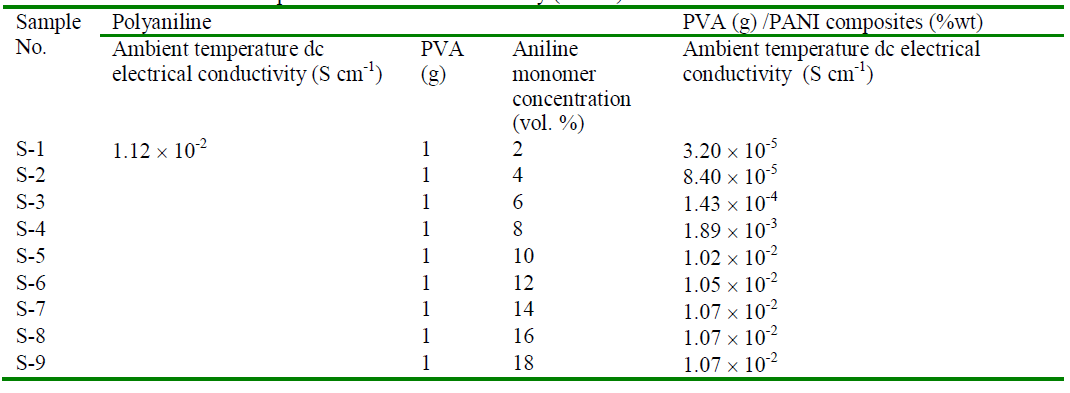 |
ELECTRICAL CONDUCTIVITY MEASUREMENTS |
| The composite samples were treated with 0.5 M aqueous solution of HCl and washed repeatedly with DMW to remove excess HCl until the filtrates gave a negative test for hydrogen ions. The sample materials were dried completely at 50 °C in the oven. Then 0.5 g material from each sample was finely ground in a mortar pastel and pellets were made at room temperature with the help of a hydraulic pressure instrument at 25 KN pressure for 20 min. The thickness of each pellet was measured by a micrometer. Four-probe electrical conductivity measurements with increasing temperatures (between 35 and 200 °C) for the composite samples were performed on pressed pellets by using a 4-in-line-probe dc electrical conductivity-measuring technique. The sample pellet to be tested was placed on the base plate of the fourprobe arrangement and the probes were allowed to rest in the middle of the pellet. A gentle pressure was applied on the probes and then it was tightened in this position so as to piercing the samples by the probes. The set-up was placed in the oven. The current was passed through the two outer probes and the floating potential across the inner pair of probes was measured. The oven supply was then switched on, the temperature was allowed to increase gradually, and the current and voltage were recorded with rise in temperature. |
III. RESULTS AND DISCUSSION |
| During present study, nine samples of electrically conducting composite materials were prepared by the incorporation of polyvinyl alcohol into the matrices of polyaniline gels prepared by mixing 250 ml of different concentrations of aniline (2 to 18% (vol.%) as monomer) with fixed volume (250 ml) of 0.1 M K2S2O8. The presence of polyaniline in polyvinyl alcohol/Polyaniline (PVA/PANI)composite is responsible for the electrical conductivity while the polyvinyl alcohol (an insulating polymer) provides mechanical stability to the end product. However, the electrical conductivity of the polymer composite is accomplished by ascertaining the percolation threshold. The electrical conductivity of the composite material may also be changed conducting to insulating range by dopoing or de-doping form which is stabilized by the polaron and bipolaron states as counter anions [12-15]. The charge-transfer reaction between the conducting component i.e. polyaniline and doping agents, HCl, is given below: [Polyaniline/PVA] + n HCl ï [Polyaniline (n H+)(n Cl-)/PVA] |
| The current-voltage data observed by a 4-in-line probe dc electrical conductivity-measuring instrument was processed for calculation of resistivity (ρο) using the following equation- ρþ = (V/I) × 2 πS |
| where V is the voltage (V) and I is the current (A). Since the thickness of the sample is small compared to the probe distance, a correction factor for it has to be applied and the corrected resistivity may be calculated as- ρ = ρο/G7 (W/S) |
| where ρ is the corrected resistivity in ohm. cm., G7(W/S) is the correction factor used in the case of non-conducting bottom surface and it is a function of W, thickness of the sample under test (cm) and S, probe spacing (cm); i.e., G7 (W/S) = (2S/W) loge2 |
| Thus, the electrical conductivity (ï³) was calculated using the following equation- σ = 1/ρ |
| where σ the electrical conductivity in Scm-1. |
| The dependence of the electrical conductivity in the composite material with respect to the concentration of aniline monomer (volume%) was examined (Table 1). The electrical conductivity of the composite material was found to increase with the increase in the concentration of aniline monomer by a sudden jump at the percolation threshold of the aniline monomer (Table 1). Interestingly at aniline concentration level of 10% (by volume), a sharp increase in conductivity appeared which may be considered as critical concentration of conducting phase. The critical concentration of conducting phase can be possibly explained on the basis of percolation theory [16]. |
| The variations of electrical conductivity (ï³) of Polyaniline/PVA composite samples (as prepared and HCl treated) (S-5) with increasing temperature (between 35 °C to 200 °C) was investigated. It was observed that the electrical conductivity of the composite samples increased with the increase in temperature and the values lie in the order of 10-4 to 10-2 S cm-1 i.e., in the semiconductor region. |
| To determine the nature of dependence of electrical conductivity on temperature plots of log ï³ versus 103T-1 K-1 were drawn (Fig. 1). It was observed that the composite material followed Arrhenius equation in accordance to other semiconductors [17]. It was also observed that the composite material showed enhanced electrical conductivity on exposure to HCl as compared to original form, due to the charge-transfer reaction between polyaniline component of the composites and doping agent, HCl as described above. |
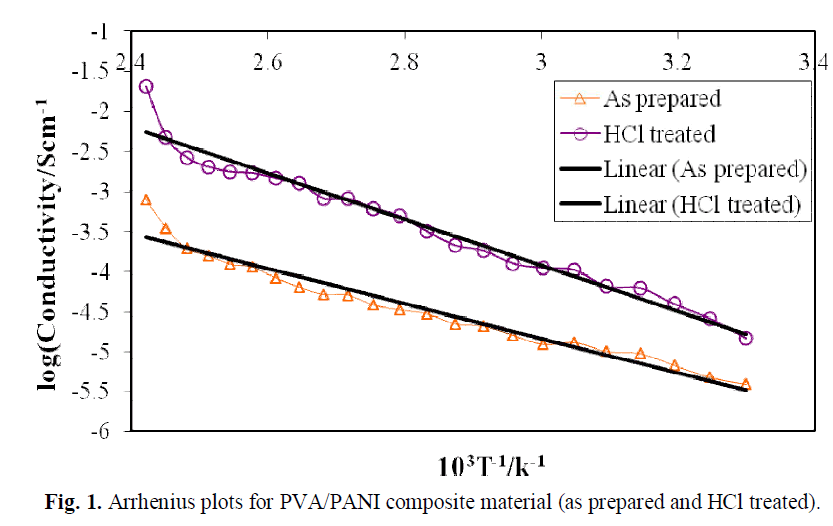 |
| The thermal stability in terms of the electrical conductivity retention was also studied under isothermal condition at different temperature (50, 70, 90, 110, 130 and 150 °C) at an interval of 15 minutes. The results are shown in Fig. 2. |
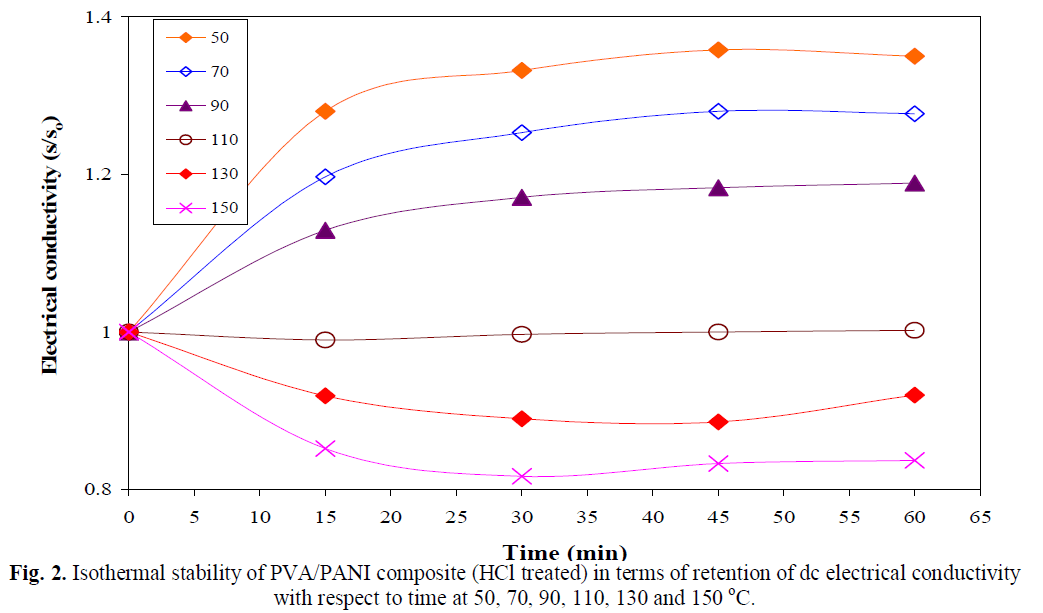 |
| The dependence of the electrical conductivity with respect to the accalarated ageing showed that the composite material is quite stable at 50, 70, 90 and 110 °C. The loss of electrical conductivity at higher (130 and 150 °C) may be attributed to the loss of dopant and the chemical reaction of dopant with the material. The stability of composite material in terms of electrical conductivity retention was also monitored for 5 cycles by repeatedly measuring linear four-probe dc electrical conductivity with increase in temperature at an interval of 45 minutes. The dc conductivity for each heating cycle was plotted as log ï³ versus 103T-1K-1 as shown in Fig. 3. |
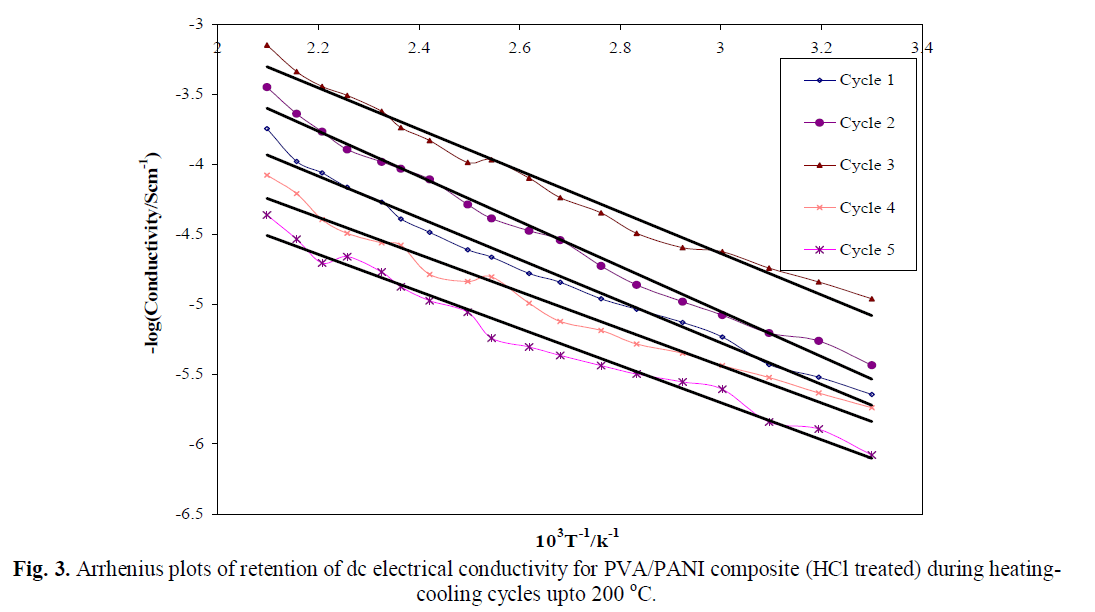 |
| It was observed that the electrical conductivity of composite materials followed the Arrhenius equation for its temperature dependence similar to other semiconductors [18]. It was obsereved that the composite material is quite stable during heating-cooling cycles under severe oxidizing conditions upto 200 °C. |
| The electrical conductivity retention in terms of the short term exposure to the environment air in the laboratory condition is also observed. It was found that the composite material is environmentally stable. PVA/PANI was also observed to be a stable material, i.e., the room temperature conductivity is negligibly affected by short-term exposure to laboratory air as evident from Fig. 4. |
IV. CONCLUSION |
| The electrical conductivity of PVA/PANI composite was determined. The results showed that the composite material electrical conductivity lies in the range of 10-4 to 10-2 S cm-1 i.e., in the semiconductor region. The electrical conductivity of the composite depends upon the percolation threshold of conducting polymer. The composite was found to be stable in terms of electrical conductivity reteion during cyclic and isothermal conditions of the measurement of electrical conductivity. It was also found environmentally stable electrically conducting polymer. |
ACKNOWLEDGEMENTS |
| The authors are thankful to the Department of Electrical Engineering, Sri Vankateshwar University Gajraula and Aligarh Muslim University, for providing necessary research facilities. |
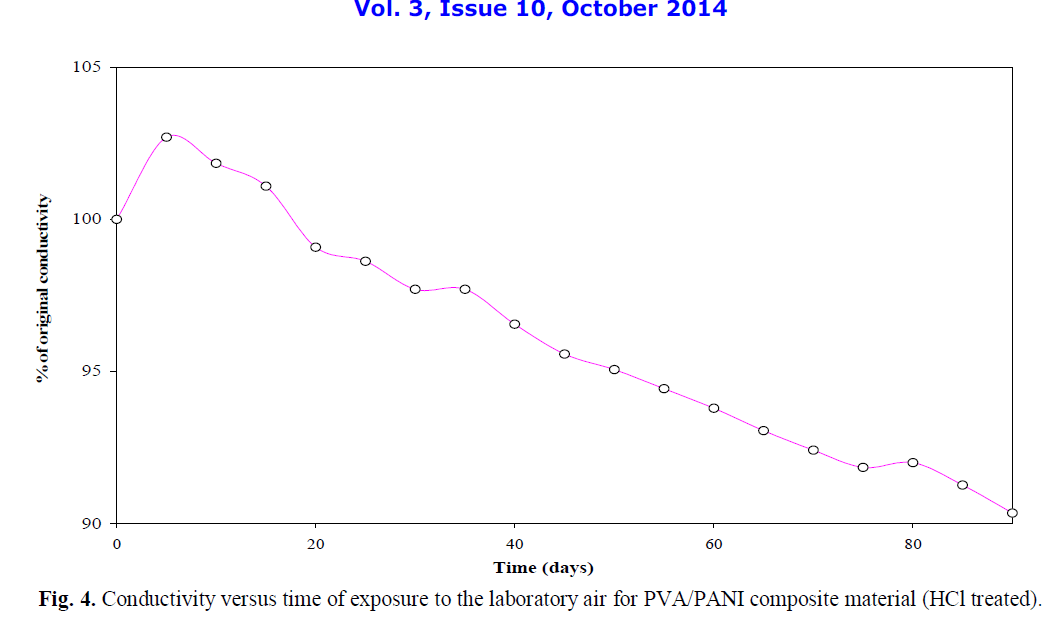 |
References |
|